CARMENES Search For Exoplanets Around M Dwarfs

(Abridged) We characterize a series of neutral vanadium atomic absorption lines in the 800–910nm wavelength region of high signal-to-noise, high-resolution, telluric-corrected M-dwarf spectra from the CARMENES survey. Many of these lines are prominent and exhibit a distinctive broad and flat-bottom shape, which is a result of hyperfine structure (HFS).
We investigate the potential and implications of these HFS split lines for abundance analysis of cool stars. With standard spectral synthesis routines, as provided by the spectroscopy software iSpec and the latest atomic data (including HFS) available from the VALD3 database, we modeled these striking line profiles. We used them to measure V abundances of cool dwarfs. We determined V abundances for 135 early M dwarfs (M0.0V to M3.5V) in the CARMENES guaranteed time observations sample. They exhibit a [V/Fe]-[Fe/H] trend consistent with that derived from nearby FG dwarfs. The tight (± 0.1 dex) correlation between [V/H] and [Fe/H] suggests the potential application of V as an alternative metallicity indicator in M dwarfs.
We also show hints that neglecting to model HFS could partially explain the temperature correlation in V abundance measurements observed in previous studies of samples involving dwarf stars with Teff≲5300K. Our work suggests that HFS can impact certain absorption lines in cool photospheres more severely than in Sun-like ones. Therefore, we advocate that HFS should be carefully treated in abundance studies in stars cooler than ∼5000K. On the other hand, strong HFS split lines in high-resolution spectra present an opportunity for precision chemical analyses of large samples of cool stars. The V-to-Fe trends exhibited by the local M dwarfs continue to challenge theoretical models of V production in the Galaxy.
The CARMENES Search For Exoplanets Around M dwarfs: Not-so-fine hyperfine-split vanadium lines in cool star spectra
Yutong Shan, Ansgar Reiners, Damian Fabbian, Emilio Marfil, David Montes, Hugo M. Tabernero, Ignasi Ribas, Jose A. Caballero, Andreas Quirrenbach, Pedro J. Amado, Jesus Aceituno, Victor J. S. Bejar, Miriam Cortes-Contreras, Stefan Dreizler, Artie P. Hatzes, Thomas Henning, Sandra V. Jeffers, Adrian Kaminski, Martin Kurster, Marina Lafarga, Juan Carlos Morales, Evangelos Nagel, Enric Palle, Vera M. Passegger, Cristina Rodriguez Lopez, Andreas Schweitzer, Mathias Zechmeister
Comments: 26 pages, 17 figures, accepted for publication in A&A
Subjects: Solar and Stellar Astrophysics (astro-ph.SR)
Cite as: arXiv:2108.12442 [astro-ph.SR] (or arXiv:2108.12442v1 [astro-ph.SR] for this version)
Submission history
From: Yutong Shan
[v1] Fri, 27 Aug 2021 18:01:07 UTC (2,669 KB)
https://arxiv.org/abs/2108.12442
Astrobiology,








